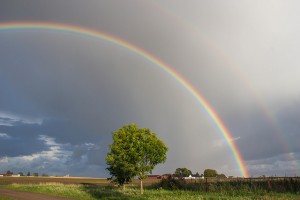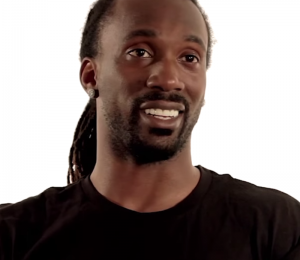
Image Credit: :Double Rainbow” by Susanne Nilsson; CC 2.0
In some ways, my immediate family starts with the story of my engagement to my wife, which actually happened at a birthday party she threw for me. When I was about to blow out the candles on the cake, I surprised her, and everyone else, by getting down on one knee and saying, “My wish is that you would marry me.” After we talked with everyone and made a number of phone calls to friends and family, we went outside and immediately saw a rainbow in the sky. We, of course, took this as a sign of God’s blessing on our engagement and marriage, and after 20 years of marriage I’m happy to report that we have not had a single argument. And if you believe that last bit, I have some ocean-front property in Oklahoma to sell you.
Interestingly, though, the rainbow has been a powerful symbol in almost every ancient and modern belief system. In my research (Wikipedia), I found these samples. In Norse mythology, the rainbow is a bridge to heaven attainable only by the virtuous or victorious in battle. In Australia, the aborigines believed the rainbow to be a gender-less creator. In Buddhism, the rainbow is the highest state available before Nirvana. In an ancient Chinese folktale, two of the colors of the rainbow, the blue and the red, are star-crossed lovers who can only be together when the rainbow appears. And maybe the most bizarre: in Bulgarian legend, if you walk under a rainbow, you might actually change genders.
A rainbow shows up in the Bible only nine chapters in. After God sends an enormous flood for forty days that wipes out most of humanity and the rest of creation, He addresses the survivors.
Then God said to Noah and to his sons with him, “Behold, I establish my covenant with you and your offspring after you, and with every living creature that is with you, the birds, the livestock, and every beast of the earth with you, as many as came out of the ark; it is for every beast of the earth. I establish my covenant with you, that never again shall all flesh be cut off by the waters of the flood, and never again shall there be a flood to destroy the earth.” And God said, “This is the sign of the covenant that I make between me and you and every living creature that is with you, for all future generations: I have set my bow in the cloud, and it shall be a sign of the covenant between me and the earth. When I bring clouds over the earth and the bow is seen in the clouds, I will remember my covenant that is between me and you and every living creature of all flesh. And the waters shall never again become a flood to destroy all flesh. When the bow is in the clouds, I will see it and remember the everlasting covenant between God and every living creature of all flesh that is on the earth.” (Genesis 9:8-16, ESV)
For believers in the God of the Bible, the rainbow is a symbol of God’s covenant love for His people. What is a covenant? A covenant is an agreement that’s made usually between two parties, with one typically being in a superior position of power. It consists of an agreement of how to act towards one another, with blessings if the covenant is kept and curses if it is broken. Ancient covenants always had symbols and rituals to attend the words of the agreement.
The theme of ‘covenant’ is a theme that runs throughout Scripture. It started in the garden when God called Adam to live in relationship with Him. Now, you may be thinking, “I don’t remember there being a covenant in Genesis 1.” And you’re right, the word ‘covenant’ is not in the first few chapters of Genesis. But, if we look at the prophetic literature of Israel, particularly Jeremiah 33, we see that God refers to His act of creation as ‘establishing a covenant’ with the day and the night, and really with all of creation. (We even see in the covenant with Noah this interesting idea of God being in covenant with more than just people when He says that the covenant is with the animals.)
You see, there has never been a time when we were not in relationship with God. It’s not as though God created Adam as an autonomous person and then decided to make a covenant with him. No, we were created to be in covenantal relationship with God at all times. And you can trace the history of Israel based on its covenants until we see a new covenant made by Jesus, in words which we celebrate every Sunday, when He said, “This cup is the new covenant in my blood.”
It’s intriguing to look at how Noah is related to two major biblical figures and where he stands in the history of the covenants.
Noah is a new Adam
Notice what God tells Noah and his sons in 9:1, “Be fruitful and multiply and fill the earth.” Do you recognize these words? This is the Creation Mandate again, just like in Genesis 1:28. It’s the same basic command God gave to Adam, with some expansion for protection of life. He gives Noah the same authority and dominion over the animals and all creation that He gave Adam.
Do you know what’s happening here? God is making all things new. The rainbow is a fitting symbol here, isn’t it? It’s a symbol of hope. Throughout the Bible, whenever God’s judgment is poured out, He always begins a new work with the remnant.
This was true with Noah and his family. In the midst of the flood, they surely must have wondered if this was how God was going to treat the world from then on. But then they found that God, in His mercy, was going to begin rebuilding and stop destroying. It was true with the second generation in the desert that entered the Promised Land with Joshua, even though their parents were barred from entering as punishment for their grumbling and sin. It was true with the Israelites who came out of exile with Ezra and Nehemiah. For each, even though hard times and punishment came upon them, they were given new life.
There are two reasons people lose hope: either they can’t get over their failures in the past and/or they don’t believe there’s anything good for them in the future. Are you in a place where it’s hard to find hope? Do you find it hard to get out of bed in the morning, even when you’ve gotten enough sleep? When you look at the future, do you think to yourself, “Don’t get your hopes up; it’s not going to get any better”?
If so, the true story of Noah is for you- it’s a reminder that God gives us a new day. He is constantly whispering, “Behold, I make all things new.” You can be part of something that God’s doing that is greater than you can imagine. If God can cause the kind of devastation that happened in the flood, think of the greater redemption and re-creation He can accomplish!
Noah is a type of Christ
The story of Noah isn’t there just to give us an example of how to act in adversity, or how God treated people way back when. It’s given to us to tell us about Jesus. I see two ways we can understand Noah as an example, or type, of Christ.
The first way is that we’re told Noah was a righteous man and did the work that God gave him to do to save both his family and a remnant of creation- in short Noah’s work ‘saved the world.’ So Jesus was a righteous man who did the work that God gave Him to save His people and bring blessing to the world.
The second way we see this typology work has to do with Noah’s name, which means ‘rest.’ It was through Noah that the land would find rest from the curse. And yet it’s only a temporary rest, as people go back to sinning and doing violence in the earth. One of Jesus’ greatest titles is “Prince of Peace,” because He is the One who will bring ultimate rest to the earth and to His people. As He says in Matthew 11, “Come unto me, all you who are weary and heavy-laden, and I will give you rest.”
We talked about the reasons people lose hope- the future looks bleak or the past is too hard to face. Here’s what this part of the story means for you, if you’re struggling with your past. Whatever you’ve done, it’s not too much for God. It won’t shock Him and it won’t ruin His image of you. He already knows you, but He can forgive you if you enter into covenant with Him.
That’s where the rainbow comes in again. Now, the ESV version has the word ‘bow,’ while other versions, like the NIV, have the word ‘rainbow.’ We could make a case that both are correct translations, because it’s obvious that God is talking about what we call rainbows, but the Hebrew word that’s used here is the word for bow, as in ‘bow and arrow.’ God is presenting a weapon of warfare as a sign of His covenant. And here’s the interesting question, which way does a rainbow points? If it pointed down, the symbolism would be that God is ready to strike us at any moment. But, thankfully, the bow points towards heaven, towards God Himself. Ironically the battle bow is a sign of peace.
Jesus Christ won that peace when He went to the cross and aimed the bow, that should have been pointing at us, directly at Himself. He took God’s wrath away from you. Now there is no longer any judgment reserved for you.
The singer Bono was once quoted as saying, “At the center of all religions is the idea of Karma. You know, what you put out comes back to you: an eye for an eye, a tooth for a tooth, or in physics…every action is met by an equal or opposite one…And yet, along comes this idea called Grace to upend all that ‘as you reap, so you will sow’ stuff. Grace defies reason and logic. Love interrupts, if you like, the consequences of your actions, which in my case is very good news indeed, because I’ve done a lot of stupid stuff.”
Do you need hope? You won’t find lasting hope outside of Jesus. He is the only source of lasting grace in a world of ‘eye for an eye.’ He says to us, “Behold, I make all things new.” Do you believe that? It’s the truest story that’s ever been told.




